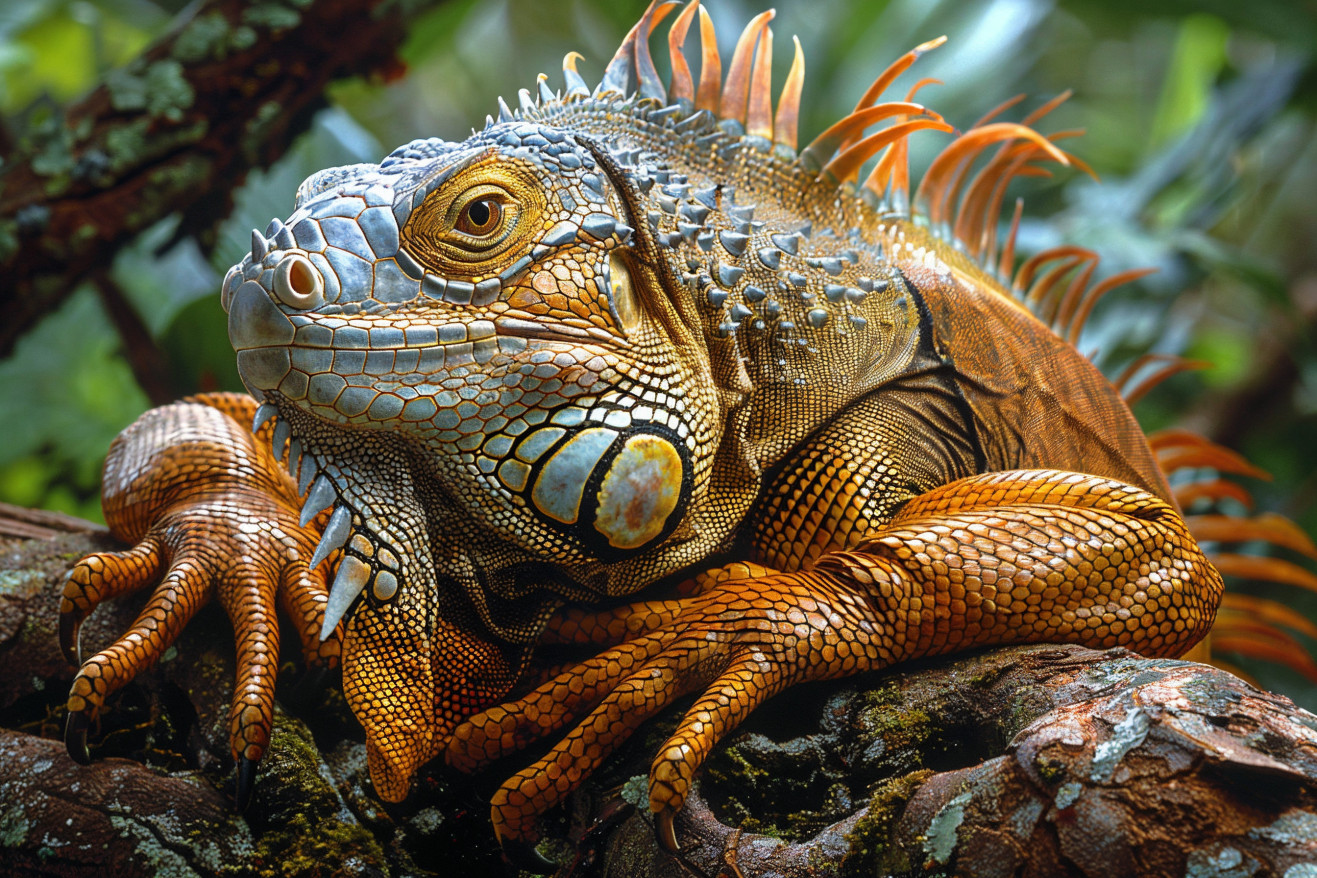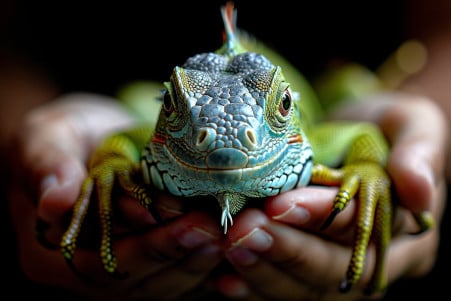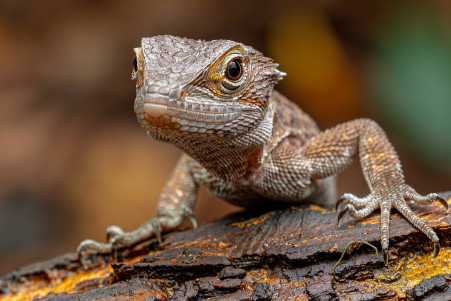Can Iguanas Be Dangerous? A Look at Their Behavior and Bite Force
14 June 2024 • Updated 13 June 2024

Iguanas may be known for their calm demeanor, but their large size and sharp teeth mean they can be dangerous if provoked. Although iguanas are not inherently dangerous, they can bite and whip their tails if they feel threatened. That said, iguanas are not likely to attack without reason, and with proper care, human injuries from iguanas are rare.
We'll look at studies by reptile researchers and animal behaviorists to understand the nuances of iguana danger. This assessment of their behavior, bite force, and natural reactions will help you better understand iguanas. By the end, you'll have a clear picture of the risks iguanas do and don't pose and how to interact with them safely, so you can put your worries to rest.
Can Iguanas Be Dangerous?
Iguana Aggression and Territoriality
Even though iguanas are usually pretty chill animals, they can be aggressive if they feel threatened or if they are protecting their territory, especially during mating seasons. According to IguanaControl.com, signs of aggression include body puffing, head bobbing, hissing, tail whipping, biting, scratching, and tail strikes. Male iguanas are more territorial and aggressive, especially when they are protecting their female partners during mating seasons.
As reported by TrutechWildlife, male iguanas are especially defensive and will thrash around if they feel threatened, which can lead to clawing and tail whipping that can cause injury. Male iguanas can grow up to 7 feet long and weigh up to 18 pounds, so an aggressive male iguana can be intimidating. Recognizing these behaviors is important so that you can recognize the signs of aggression and avoid situations that will lead to an aggressive response.
If your iguana is showing signs of aggression, experts at Anapsid.org suggest staying calm, backing away, and not making direct eye contact or sudden movements that could make the situation worse. Standing your ground and speaking firmly can help you deal with a male iguana that is acting out because of mating behavior. By respecting their territoriality and giving them space, you can often avoid bites and strikes.
Iguana Bite Force and Defensive Capabilities
Iguanas have sharp, serrated teeth that can cause significant damage through bites, but iguanas are not likely to bite unless they feel threatened. According to IguanaControl.com, iguanas' jaws are strong and their bite force is powerful, which means that if they do bite, the results can be serious, including broken bones or bacterial infections if the skin is broken.
In addition to biting, iguanas have tails and claws that they can use to defend themselves. Both can cause painful strikes or scratches. As explained by The Spruce Pets, iguanas have sharp claws that can cause scratches, and their tails are strong enough to whip and cause injury. Knowing this information can help you understand the potential danger of an iguana's bite and other defensive moves.
Proper handling, including supporting the iguana's body and avoiding sudden movements, can help prevent defensive reactions and injuries. Reptiles Magazine notes that you should always be cautious when you're around an iguana because even if they aren't showing signs of aggression, they can suddenly become aggressive. By being aware of their potential for aggression, you can safely interact with iguanas.
How to Handle and Tame a Pet Iguana
Although iguanas are not fully domesticated, they can be tamed and will often respond well to handling and socialization if they are given time to adjust to their new environment. The Spruce Pets recommends that new iguanas be given time to acclimate to their new surroundings before any attempts at handling or taming are made.
Taming a pet iguana is a delicate balance of being firm but not stressing the iguana, and using gentle handling and positive reinforcement. The Spruce Pets article explains that you need to be consistent but not to the point of stressing the iguana out. Proper handling is especially important for larger iguanas, and it involves supporting the belly and pelvic areas to avoid injury and defensive reactions.
Learning how to read iguana body language and how to recognize signs of stress and aggression is essential to safely handling and interacting with pet iguanas. According to The Spruce Pets, head bobs, dewlap extensions, and tail twitching are all signs that an iguana feels threatened and may become aggressive. If their natural behaviors are respected and they are given a safe and predictable environment, iguanas can become calm and manageable pets.
Housing and Care for Pet Iguanas
Iguanas need a large, properly sized enclosure with the right temperature, humidity, and lighting to be healthy. Per Petco, an adult iguana should have an enclosure that is at least 12 feet long by 6 feet wide by 6 feet high to ensure that they have enough space to move around and climb. The enclosure should have climbing branches and vines, as well as hiding spots and a substrate that is safe to ingest, such as paper-based pellets or reptile carpet.
It's also important to make sure that the temperature gradient is correct, with the warm end reaching 100-120°F and the cool end staying at 80°F. Per VCA Animal Hospitals, iguanas need the humidity in their enclosure to stay between 70-80%, which can be maintained by misting and soaking. In addition, iguanas need UVA and UVB light for 10-12 hours a day to help them make vitamin D and absorb calcium.
Iguanas need a diverse, herbivorous diet that includes leafy greens, vegetables, and some fruits, and they also need calcium and vitamin supplements. Per wikiHow, iguanas also need regular vet visits, help with shedding, and nail trims. If these needs aren't met, iguanas can develop serious health problems like metabolic bone disease and respiratory infections.
Iguana Diseases and Health Concerns
Iguanas are known to carry bacteria such as Salmonella, which can lead to salmonellosis in humans. Critter Control notes that the bacteria is found in the lining of the iguana’s intestinal tract and can be transmitted through their feces, skin, and saliva. People can get salmonellosis from iguanas through direct contact or indirect contact through contaminated food, water, or surfaces.
The team at IguanaControl.com explains that while healthy adults may experience mild gastroenteritis, children, the elderly, and immunocompromised individuals are at higher risk for severe salmonella infection. Preventing the spread of salmonellosis and other diseases requires good hygiene, including washing your hands thoroughly after handling iguanas and keeping their enclosures clean.
In addition to salmonella, iguanas can develop a number of other health issues if they aren’t cared for properly, including metabolic bone disease, mouth rot, and respiratory infections. The Jackson Vet blog notes that this is important information for both iguana pet owners and people who may come into contact with wild iguanas. Many of these health issues can be prevented by ensuring that iguanas have the right housing, diet, and veterinary care.
Conclusion: Finding a Balance Between Risk and Responsible Ownership
Although iguanas can present risks due to their size, defensive nature, and potential to spread disease, these risks can be minimized with responsible ownership and proper precautions. This includes learning about iguana behavior, understanding the signs of aggression, and avoiding situations that may lead to an aggressive response.
For those interested in keeping iguanas as pets, providing the right kind of housing, care, and socialization can help ensure that both the iguana and the people who care for it are safe and healthy. With the right information and precautions, people can enjoy the unique characteristics of these unusual reptiles while minimizing the risks they may pose.
In the end, responsible ownership and a thoughtful approach to interacting with iguanas can help protect both people and these interesting animals.


